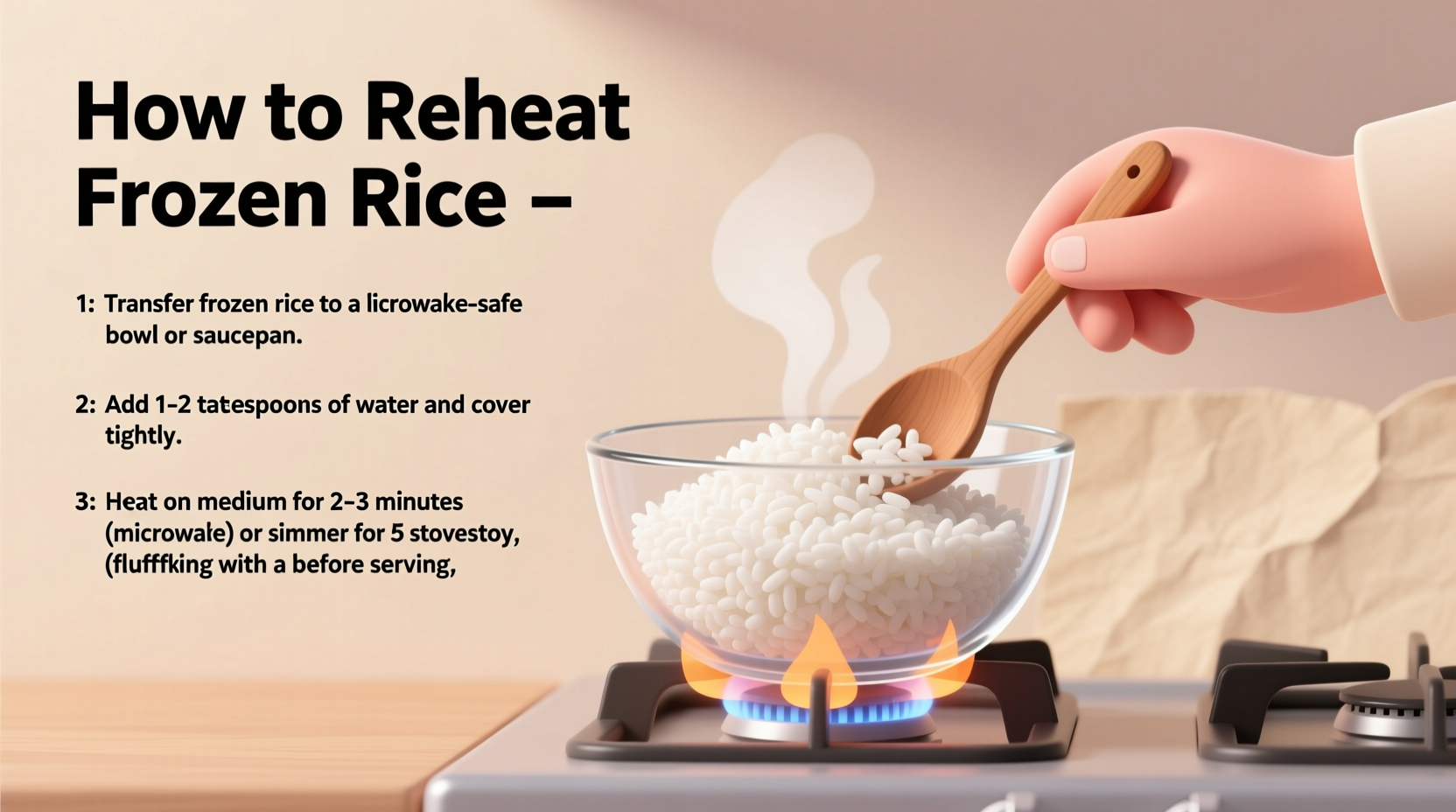Leftover rice properly stored in the freezer can be a lifesaver for busy weeknights. But that frozen block often turns into a soggy mess or dry clump when reheated incorrectly. As a culinary professional who's taught thousands of home cooks, I've refined the most reliable techniques to transform frozen rice into restaurant-quality results every time.
Why Frozen Rice Needs Special Treatment
Rice undergoes starch retrogradation when frozen, causing moisture loss and texture changes. The FDA confirms that improperly reheated rice can harbor Bacillus cereus spores that survive cooking and multiply during improper cooling or reheating. This is why technique matters more than you might think.
| Reheating Method | Time Required | Texture Result | Best For |
|---|---|---|---|
| Microwave | 3-5 minutes | Good (slightly uneven) | Quick single servings |
| Stovetop | 8-10 minutes | Excellent (most consistent) | Daily cooking, best texture |
| Steaming | 10-12 minutes | Superior (lightest texture) | Sushi rice, delicate varieties |
| Oven | 15-20 minutes | Very good (even heating) | Large batches, meal prep |
Critical Food Safety Timeline
According to USDA Food Safety guidelines, cooked rice enters the danger zone (40°F-140°F) within 2 hours at room temperature. When reheating frozen rice:
- Thaw in refrigerator for 12-24 hours for safest results (USDA recommends this method)
- Never thaw at room temperature for more than 2 hours
- Always reheat to internal temperature of 165°F (74°C)
- Consume within 1-2 hours after reheating
Professional Method 1: Stovetop Revival (Best Texture)
This technique gives you the most control for perfect results:
- Place frozen rice in a non-stick skillet with 1-2 tablespoons of water per cup of rice
- Cover with tight-fitting lid and heat on medium-low for 5 minutes
- Reduce heat to low, fluff rice gently with fork, and add 1 teaspoon of oil or butter
- Cover and cook 3-5 more minutes until steam creates gentle bubbling sound
- Remove from heat and let stand covered for 2 minutes before serving
This method works because the controlled steam environment mimics the original cooking process, allowing starch granules to properly rehydrate. Professional chefs prefer this approach as it prevents the common mistake of adding too much liquid at once.
Quick Method 2: Microwave Magic (3-Minute Solution)
For when you need rice immediately:
- Place frozen rice in microwave-safe bowl with 1 tablespoon water per cup
- Cover tightly with microwave-safe lid or damp paper towel
- Microwave on 50% power for 2 minutes, then stir gently
- Microwave additional 1-2 minutes until heated through
- Let stand covered for 1 minute before fluffing

Avoid These Common Mistakes
Even with proper technique, these errors ruin reheated rice:
- Skipping the moisture step - Frozen rice needs water reintroduction
- Using high heat - Creates steam pockets that make some parts mushy while others remain frozen
- Over-stirring - Breaks rice grains and creates paste-like consistency
- Reheating multiple times - Increases bacterial risk with each cycle
Special Considerations by Rice Type
Not all rice reheats the same. Understanding these context boundaries prevents disappointment:
- Jasmine/Basmati: Add 10% less water - these delicate grains become mushy easily
- Sushi rice: Use rice vinegar mist (1 tsp vinegar + 2 tbsp water) for authentic texture
- Wild rice blends: Require 2-3 minutes extra cooking time due to harder grains
- Fried rice: Best reheated in skillet with small oil amount to restore crispness
Pro Storage Tips for Future Success
How you freeze rice determines reheating success. Follow these professional storage guidelines:
- Cool cooked rice within 1 hour of cooking (critical food safety step)
- Portion into single-serving containers or freezer bags
- Flatten bags to ½-inch thickness for quick, even freezing
- Label with date - consume within 3 months for best quality
- Remove excess air from packaging to prevent freezer burn
Troubleshooting Reheated Rice Problems
Fix these common issues with targeted solutions:
- Dry and hard: Sprinkle with 1 tsp water and reheat 60 seconds more
- Mushy texture: Spread on baking sheet and bake at 300°F for 5-8 minutes
- Cold spots: Break up frozen chunks before reheating and stir midway
- Off taste: Rice stored longer than 3 months - discard immediately
Can you reheat frozen rice directly without thawing?
Yes, you can safely reheat frozen rice without thawing, but you'll need to increase liquid by 50% and cooking time by 3-5 minutes. The USDA confirms this method is safe as long as rice reaches 165°F (74°C) internal temperature throughout.
Why does my reheated frozen rice become mushy?
Mushy rice occurs when too much water is added or heat is too high, causing starch granules to rupture. Professional chefs recommend using less water than you think necessary and low, steady heat to allow gradual moisture absorption without breaking down the rice structure.
How many times can you safely reheat frozen rice?
Food safety experts recommend reheating rice only once. Each cooling and reheating cycle increases the risk of bacterial growth. The FDA advises against multiple reheating cycles, especially for rice which provides ideal conditions for Bacillus cereus bacteria.
What's the best way to reheat frozen rice for fried rice?
For perfect fried rice, thaw frozen rice in the refrigerator first, then spread on a baking sheet and refrigerate uncovered for 1 hour to dry slightly. Professional wok chefs recommend this method because drier rice separates better and achieves proper wok hei (breath of the wok) without steaming.











 浙公网安备
33010002000092号
浙公网安备
33010002000092号 浙B2-20120091-4
浙B2-20120091-4